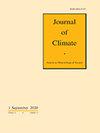Disagreement on the North Atlantic Cold Blob Formation Mechanisms among Climate Models
IF 4
2区 地球科学
Q1 METEOROLOGY & ATMOSPHERIC SCIENCES
引用次数: 0
Abstract
Abstract Despite global warming, sea surface temperature (SST) in the subpolar North Atlantic has decreased since the 1900s. This local cooling, known as the North Atlantic cold blob (North Atlantic cold blob), signifies a unique role of the subpolar North Atlantic in uptaking heat and hence impacts downstream weather and climate. However, a lack of observational records and its constraints on climate models leave the North Atlantic cold blob formation mechanism inconclusive. Using simulations from the Coupled Model Intercomparison Project Phase 6, we assess the primary processes driving the North Atlantic cold blob within individual models and the consistency of mechanisms across models. We show that 11 out of 32 models, which we call “Cold Bold” models, simulate subpolar North Atlantic cooling over 1900–2014. Further analyzing the heat budget of subpolar North Atlantic SST shows that models have distinct mechanisms of cold blob formation. Whereas four out of the 11 Cold Blob models indicate decreased Oceanic Heat Transport Convergence (OHTC) as the key mechanism, another four models suggest changes in radiative processes making predominant contributions. The contribution of OHTC and radiative processes are comparable in the remaining three models. Such a model spread in the mechanism of cold blob formation may be associated with distinct base-state Atlantic Meridional Overturning Circulation (AMOC) strength, which explains about 39% of the inter-model spread in the contribution of OHTC to the simulated cold blob. Models with a stronger base-state AMOC suggest a greater role of OHTC, whereas those with a weaker base-state AMOC indicate radiative processes are more responsible. This model discrepancy suggests that the cold blob formation mechanism diagnosed from single models should be interpreted with caution.各种气候模式在北大西洋冷团形成机制上的分歧
摘要 尽管全球变暖,但自 20 世纪以来,北大西洋副极地的海面温度(SST)却有所下降。这种局部降温现象被称为 "北大西洋冷球"(North Atlantic cold blob),表明北大西洋副极地在吸收热量方面发挥着独特的作用,从而影响下游的天气和气候。然而,由于缺乏观测记录及其对气候模式的制约,北大西洋冷球的形成机制尚无定论。利用耦合模式相互比较项目第六阶段的模拟结果,我们评估了各个模式中驱动北大西洋冷球的主要过程,以及不同模式间机制的一致性。我们发现,在 32 个模式中,有 11 个(我们称之为 "冷大胆 "模式)模拟了 1900-2014 年期间北大西洋副极地的降温。进一步分析北大西洋副极地海温的热量预算可以发现,各模式的冷球形成机制各不相同。在 11 个冷球模型中,有 4 个模型表明海洋热传输辐合(OHTC)的减少是关键机制,而另外 4 个模型则表明辐射过程的变化是主要原因。在其余三个模式中,OHTC 和辐射过程的作用相当。冷球形成机制在模式间的这种差异可能与大西洋经向翻转环流(AMOC)基态强度不同有关。基态 AMOC 较强的模式表明 OHTC 的作用更大,而基态 AMOC 较弱的模式表明辐射过程的作用更大。这种模式差异表明,应谨慎解释从单一模式得出的冷球形成机制。
本文章由计算机程序翻译,如有差异,请以英文原文为准。
求助全文
约1分钟内获得全文
求助全文
来源期刊

Journal of Climate
地学-气象与大气科学
CiteScore
9.30
自引率
14.30%
发文量
490
审稿时长
7.5 months
期刊介绍:
The Journal of Climate (JCLI) (ISSN: 0894-8755; eISSN: 1520-0442) publishes research that advances basic understanding of the dynamics and physics of the climate system on large spatial scales, including variability of the atmosphere, oceans, land surface, and cryosphere; past, present, and projected future changes in the climate system; and climate simulation and prediction.
 求助内容:
求助内容: 应助结果提醒方式:
应助结果提醒方式:


